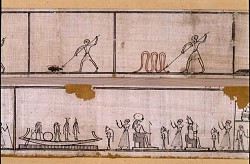
El nombre le fue dado al 'libro' por Maspero, y hace referencia a las puertas guardadas por porteros que dividen las diferentes fases de la noche.
En común con el Amduat, el Libro de las Puertas tiene el tema del viaje del sol y el reino de los muertos, la división del Más Allá en doce horas (o departamentos) y los tres registros. Además, contiene una escena de juicio con textos criptográficos y una ilustración final. La escena central del juicio, que tiene lugar al final de la quinta hora, aparece pintada en la tumba de Horemheb en medio del muro que se encuentra detrás del sarcófago. La palabras del fallecido son ?pesadas? en el salón del juicio delante de Osiris y los jueces, los bienaventurados eran alimentados, mientras que los pecadores eran destruidos.
No se sabe con exactitud cuándo apareció el Libro de las Puertas; pese a que algunos investigadores sugieren como fecha el Imperio Medio o incluso el Primer Periodo Intermedio, probablemente fuera redactado durante el reinado de Amenofis III y utilizado por primera vez en una tumba por Horemheb, en parte para reemplazar el Libro del Amduat. En adelante, los dos más antiguos Libros sobre el Más Allá aparecerán juntos en la mayoría de las tumbas reales del las Dinastías XIX y XX. El sarcófago de Sethy I contiene un ejemplo completo.
Después del Imperio Nuevo, el Libro de las Puertas no vuelve a encontrarse en los muros de las tumbas, aunque aparece en fragmentos de papiro y sarcófagos de la Dinastía XXI de personas no pertenecientes a la realeza. Sólo en la Dinastía XXVI aparecerá el Libro de las Puertas junto a otros Libros del Más Allá en la ricamente decorada tumba de Pentamenofis. En la Baja Época, cuando la decoración de sarcófagos se encontraba en una nueva Edad de Oro inspirada por las tumbas y sarcófagos reales del Imperio Nuevo, los particulares comenzaron a utilizar la escena del juicio así como parte de la primera hora. La ilustración final, que representa el final del viaje a través de la noche, ya había comenzado a aparecer en papiros mitológicos y en Libros de los Muertos de la Dinastía XXI.